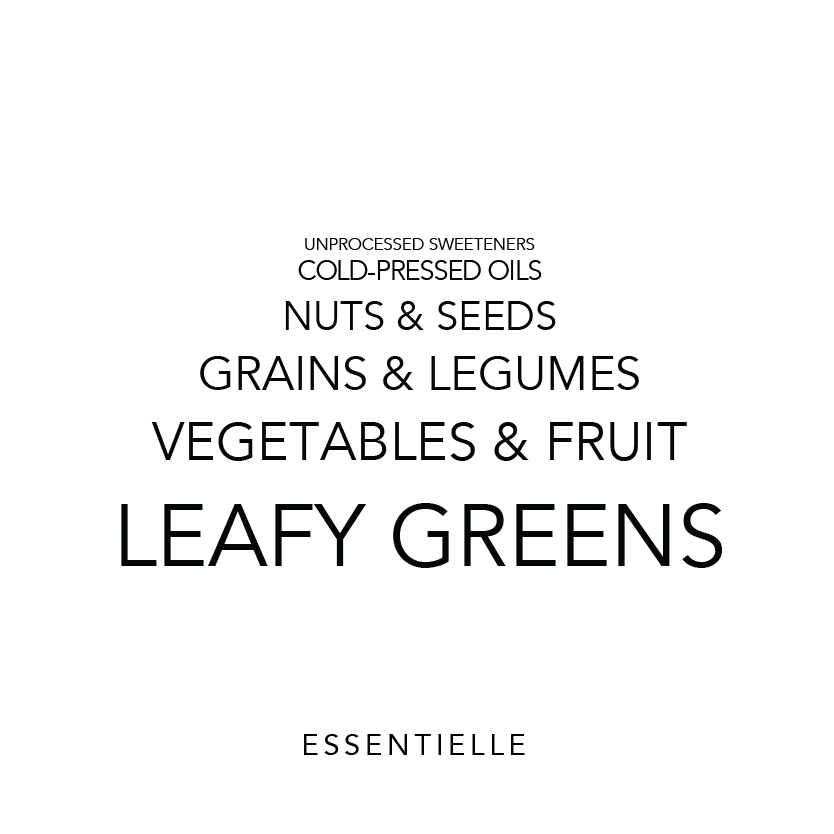
Our bodies are designed to digest what nature grows. Any additives found in processed packaged foods lead to inflammation and disease in the body, resulting in health issues. You can get all your nutritional needs met by eating fruit, vegetables, grains, legumes, nuts & seeds in abundance. This is what will lead you to a feeling amazing with a fit physique and youthful complexion.
Leafy Greens. Leafy greens are the base of the Essentielle food pyramid; they should make up the majority of each of our meals because they provide valuable live enzymes, phytonutrients, minerals, fiber and antioxidants to help with digestion and keep our body operating at homeostasis, its optimal balance. We try to aim for at least 4-6 cups daily which sounds like a lot but it will do wonders for you as leafy greens are literally the fountain to youth. There are so many ways to use them, from green smoothies for breakfast to big salads at lunchtime to sautéed or steamed greens at dinner. Get adventurous and try new kinds that speak to you at your farmer’s market or local grocery store.
Fruit. No need to be scared of fruit! Unfortunately, a lot of people think that the sugar in fruit will make them gain weight. The opposite is true! A banana does not equal a candy bar. While the candy bar is pure processed sugar, the banana contains essential minerals, vitamins, live enzymes and fiber which slows down the release of the fruit sugar into the blood stream. Fruit is actually the human’s perfect food, clean, easy to digest and a great source of energy.
Vegetables. Vegetables are another food that should be the main event on our plates since our microbiome prefers a wide variety of plants. Only plant foods contain fiber which is what our microbiome feeds off, it is key to weight management and satiety. Eating the rainbow is not an empty term, different vegetables provide you with different nutrients, minerals and vitamins. Cruciferous vegetables such as broccoli and cauliflower give you youthful cells while root vegetables like squash, potatoes and sweet potatoes contain amazing complex carbs. There is so much choice and your gut will thank you later if you choose to eat the rainbow on a daily basis.
Gluten-free Grains. Grains have been sustaining populations for centuries and in their whole unrefined state they are a health food. This includes quinoa (technically a seed), rice, millet, gluten-free oats, buckwheat, amaranth, millet and teff. Gluten is an inflammatory protein that the body can’t digest well so it’s better to avoid most of the time even if you do not have a confirmed intolerance. Inflammation is the most common cause of any disease, skin problems, stomach- and digestive issues as well as weight gain so as a reset, it’s worth it to cut gluten out for a while and see how you feel.
Legumes. Legumes are literally nature’s all-in-one package since they provide us with valuable plant-protein, complex carbs and lots of fiber. They are satiating and super versatile to cook with from salads to curries to pasta sauce (or as pasta itself if you use legume pasta), the options are endless!
Nuts, Seeds, cold-pressed Oils. Nuts and seeds are little nutritional powerhouses! They contain valuable unsaturated fats and protein and make great snacks, dressings and desserts as they are so versatile. While I am personally intolerant to tree nuts, my recipes are generally nut-free (except for peanuts which are a root plant and not a nut) and I substitute them with seeds like sunflower seeds but if you tolerate them well they make great snacks and are versatile for plant-based cooking. Oils are refined and not a whole food that’s why we should use them in a limited amount. However, cold pressed oils like extra virgin olive oil, avocado oil and coconut oil contain good fats and are a vital part of a healthy diet to be used in salads, for cooking and baking.
Unprocessed Sweeteners. Instead of relying on refined sugars, try natural alternatives such as honey, maple syrup or coconut sugar. While I still think these natural sweeteners should only be used in moderation, they at least provide you with nutritional benefits such as minerals and antioxidants.
Try to reset your palate and taste the natural sweetness of foods. Your tastebuds will take some time to adjust, but soon you will appreciate the more subtle flavor profiles of whole foods and those packaged cookies will taste much too sweet. Eat an abundance of this instead: fruit which is nature’s candy (again, no need to be afraid of it – so much nutritional value plus fiber which won’t make your blood sugar spike), sweet root vegetables (carrots, squash, sweet potatoes) and spices such as cinnamon which taste sweet and cozy yet are great blood sugar stabilizers.